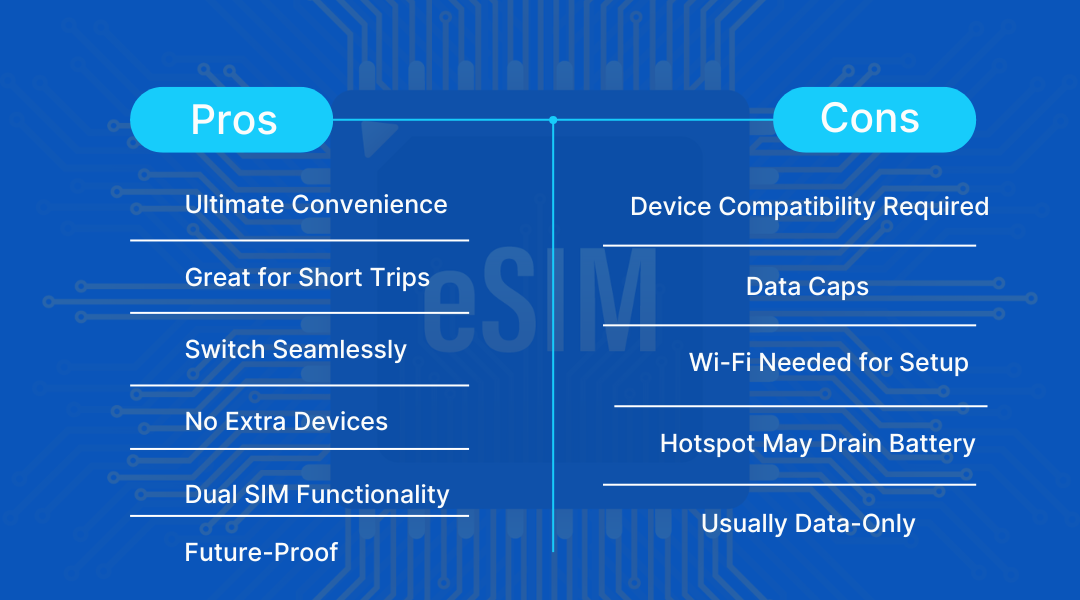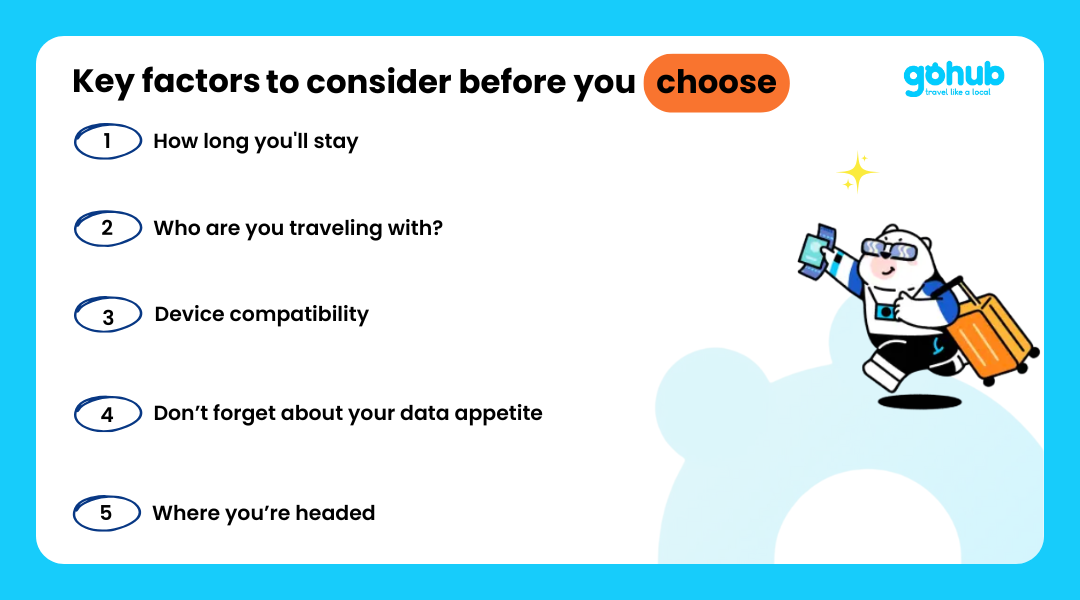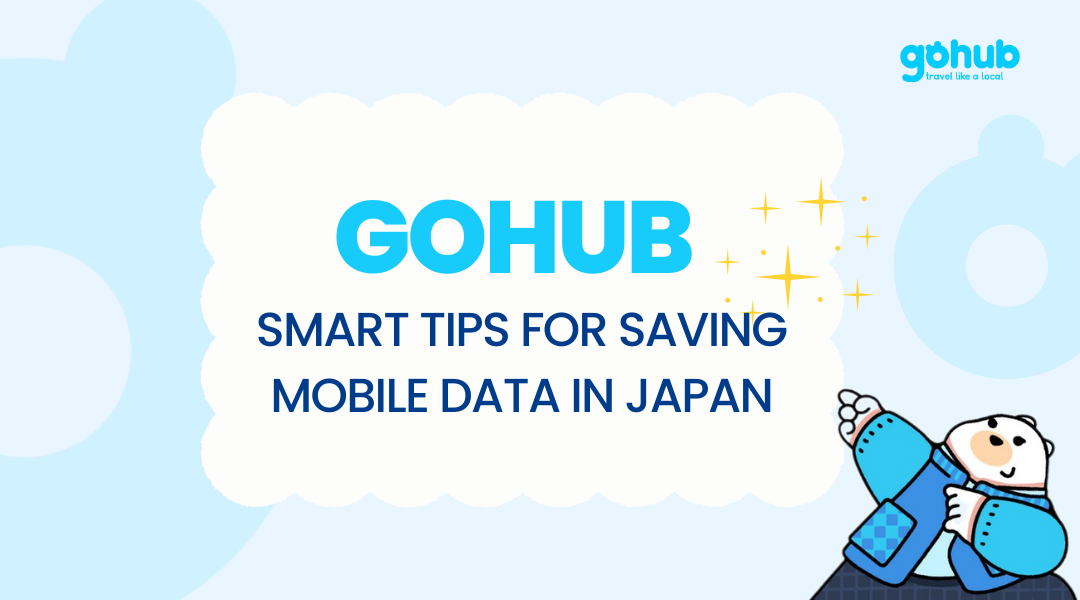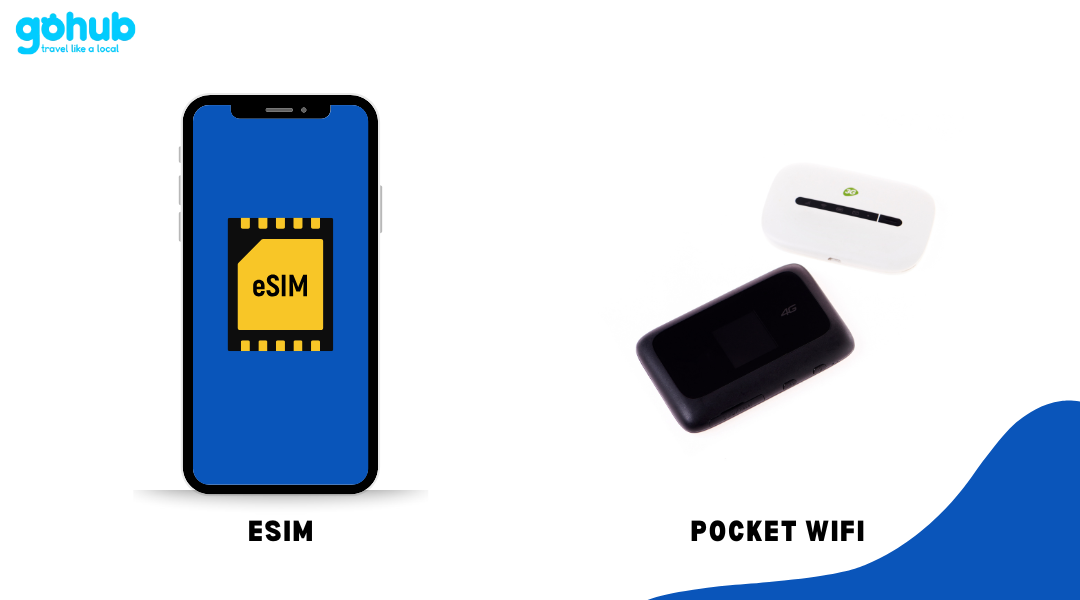Planning your adventure to the Land of the Rising Sun? Great choice! From neon-lit Tokyo streets to serene Kyoto temples, Japan is a place where every moment is worth sharing — and staying connected makes it all even better.
Sure, there’s free Wi-Fi here and there, but let’s be honest:
You don’t want to get stuck offline when you’re navigating crowded train stations, translating menus, or hunting down that hidden ramen shop everyone raves about.
That’s why choosing the right internet setup — whether a Japan travel eSIM or Pocket Wifi — is key to traveling smarter.
👉 If you’re looking for unbeatable convenience, instant setup, and reliable coverage across Japan, Gohub’s Japan eSIM is the best pick to keep you connected every step of the way!
In this guide, we’ll break down the pros and cons of eSIM vs pocket wifi for Japan, plus how to pick the perfect option based on your travel style.
Ready? Let’s dive in and get you connected in true Gohub style!

I. Why Reliable Internet is a Must in Japan
In Japan, having solid internet isn’t just a nice-to-have — it’s a total game-changer for your trip.
Here’s why you’ll want to stay connected in Japan at all times:
- Navigation and Maps: Google Maps is your best friend for trains, buses, and even finding tiny hidden cafes.
(Offline maps are great backups, but real-time updates save you serious headaches.) - Translation Help: Not everything has English signs.
Apps like Google Translate help you decode menus, signs, and quick conversations — on the spot. - Train Schedules and Route Planners: Japan’s train system is legendary… and sometimes confusing!
Apps like HyperDia and Japan Transit Planner need real-time internet to pull the latest schedules. - Stay in Touch: Whether it’s WhatsApp, Line, or Facetime — staying connected with your travel buddies or family back home relies on good data.
- Find the Best Spots: Looking for that hidden sushi bar or last-minute shrine visit?
You’ll need a reliable connection to search, book, and navigate on the go.
II. Option 1: eSIM — The Smart Way to Stay Connected
An eSIM (embedded SIM) is a digital SIM built right into your smartphone.
No plastic cards, no fiddling with tiny trays — just scan a QR code, and you’re connected!
Here’s why eSIMs for Japan travel are so popular:
✅ Pros of Using an eSIM in Japan
- Ultimate Convenience:
Buy and activate online before you even leave home. No store visits, no airport queues. - Great for Short Trips:
Japan eSIM plans are usually cheaper than roaming — especially for solo travelers or couples. - Switch Seamlessly:
Easily swap between your eSIM data plan and your home SIM for calls/texts. - No Extra Devices:
No need for a separate hotspot — your phone does it all. - Dual SIM Functionality:
Many phones let you keep your home number active while using the eSIM for local data. - Future-Proof:
eSIM technology is the way forward — many new phones only have eSIM slots now!
⚠️ Cons of Using an eSIM in Japan
- Device Compatibility Required:
Your phone must support eSIM. (Most newer iPhones, Samsung Galaxy, and Google Pixels do.) - Data Caps:
Most tourist Japan eSIM plans have set data limits. Heavy users might need to top up. - Wi-Fi Needed for Setup:
You’ll need Wi-Fi to install your eSIM profile (easy if done at the airport or hotel). - Hotspot May Drain Battery:
Sharing your eSIM connection with other devices can eat up battery fast. - Usually Data-Only:
No local Japanese number for calls/SMS unless you use apps like WhatsApp or Line.
🎯 Traveler Tip:
If you want zero hassle and full freedom, Gohub’s Japan eSIM is one of the easiest and most affordable ways to stay connected across Japan!

III. Option 2: Pocket WiFi — Shareable Internet On the Go
A Pocket WiFi is like carrying your own mini Wi-Fi router around Japan.
It connects to the mobile network and lets multiple devices share the internet — just like at home!
Here’s why Pocket WiFi for Japan travel is a favorite for many groups:
✅ Pros of Using Pocket WiFi in Japan
- Connect Multiple Devices:
Perfect for families, groups, or travelers with phones, tablets, laptops — all at once. - Great for Locked Phones:
If your phone is carrier-locked, no worries. Pocket WiFi connects through Wi-Fi, not your SIM. - Larger Data Allowances:
Some rentals offer big data bundles or advertise unlimited plans (always double-check fine print!). - Simple Setup:
Turn it on, find the network name (SSID), enter the password — you’re connected. - Reliable Coverage:
Connects through major Japanese networks for good coverage in cities and tourist spots. - Good for Longer Trips:
If you’re staying in Japan for a few weeks and splitting costs with friends, it can be very economical.
⚠️ Cons of Using Pocket WiFi in Japan
- Another Gadget to Carry:
It’s one more thing to remember (and recharge). - Daily Charging Needed:
Pocket WiFi battery usually lasts 6–12 hours — bring a power bank if you’re out all day. - Pickup and Return Hassle:
You’ll need to arrange pickup at the airport/hotel and return it properly to avoid extra charges. - Risk of Loss or Damage:
Losing or damaging a Pocket WiFi can result in hefty fees. - Limited Range:
Everyone has to stay close to the device. Split up too far, and someone might lose connection.
🎯 Traveler Tip:
If you’re traveling solo or just with one buddy, a Pocket WiFi might feel like too much.
But for bigger groups, Pocket WiFi Japan travel deals can save a lot!:
IV. Key Factors to Consider Before You Choose 🧠✨
Choosing between a Japan travel eSIM and Pocket WiFi isn’t about right or wrong — it’s about finding what fits your style best.

Let’s walk through a few real traveler questions you should ask yourself:
First, think about how long you’ll stay.
If you’re in Japan for just a week or so, an eSIM offers unbeatable simplicity — no pickups, no returns. But if you’re staying for a month or traveling with a big group, a Pocket WiFi rental might save you more in the long run.
Next, who are you traveling with?
Solo adventurers and couples love how easy an eSIM is — just scan and connect. But if you’re with family or a bunch of friends juggling phones, tablets, and laptops, a Pocket WiFi that covers everyone can be a smarter move.
Device compatibility is another deal-breaker.
Modern smartphones like iPhone XR and newer support eSIM. If your phone doesn’t, or if you’re not sure, a Pocket WiFi is the safe, simple fallback.
Don’t forget about your data appetite either.
If you mostly use Google Maps, Line, and quick translations, most Japan eSIM plans will have you covered. But if you plan to stream Netflix on Shinkansen rides or have constant Zoom meetings, a Pocket WiFi with a big data package might be your best friend.
Where you’re headed matters too.
Both options work beautifully in Tokyo, Kyoto, and Osaka. But if you’re venturing into rural villages or hiking Mount Fuji, double-check coverage maps. Some eSIMs — like Gohub’s Japan eSIM — smartly connect to multiple networks, boosting your chances of getting signal in remote areas.
Finally, how comfortable are you with tech?
Installing an eSIM is quick (usually under 5 minutes), but you do need Wi-Fi at first. If you prefer pure plug-and-play, Pocket WiFi is super simple: just turn it on and you’re good to go.
🎯 Traveler Tip:
For most travelers who love flexibility and hate extra gadgets, an eSIM from Gohub will make your Japan trip much smoother — and lighter on your backpack too!
V. Smart Tips for Saving Mobile Data in Japan

Whether you’re using a Japan travel eSIM or a Pocket WiFi, being mindful of your data usage will help you stay connected longer — and maybe even save a few yen along the way!
Here are a few practical tricks to keep your data bills light:
First, take advantage of free Wi-Fi whenever you can.
Many cafes, train stations, hotels, and even some convenience stores like Lawson and 7-Eleven offer free Wi-Fi. Just remember — public Wi-Fi isn’t always secure, so avoid logging into sensitive accounts while connected.
Another easy win is downloading offline essentials before heading out.
Save Google Maps offline for the areas you’ll visit, pre-load translation phrases on Google Translate, and even download your Netflix episodes before flying. That way, you won’t burn through precious data on simple tasks.
You’ll also want to turn off background app refresh.
Apps love to sneakily use data even when you’re not looking. On iPhone and Android, you can disable background data for apps that don’t need it while traveling.
Be extra careful with streaming and video calls.
Watching YouTube in HD or long FaceTime chats with friends back home can eat through a 5GB plan shockingly fast. Try to limit these to when you’re on free Wi-Fi.
Finally, if you’re using a Pocket WiFi, share responsibly.
The more people and devices connected at once, the faster the data drains — especially if everyone’s uploading photos to Instagram at the same time!
🎯 Traveler Tip:
Little habits — like switching to offline maps and disabling autoplay videos — can help you save mobile data in Japan without even thinking about it.
VI. Conclusion: eSIM or Pocket WiFi — Which One Wins for Japan?
Staying connected in Japan isn’t a luxury — it’s the secret to a smoother, more unforgettable trip.
Whether you’re using Google Maps to find hidden ramen shops, translating a menu, or booking that last-minute Shinkansen ticket — good internet makes travel magic happen.
So, eSIM vs Pocket WiFi — what’s the final call?
👉 If you want simplicity, no extra gadgets, and instant setup the moment you land, a Japan travel eSIM — like Gohub’s eSIM — is hands-down the smarter choice.
Perfect for solo travelers, couples, and anyone who loves to travel light.
👉 If you’re traveling with a big group, carrying laptops and tablets, and want to share one connection for everyone, Pocket WiFi might be a better fit — just be ready to manage one more device.
🎯 Quick Tip:
Most travelers today are switching to eSIMs because they’re easy, affordable, and future-proof.
And with Gohub’s Japan eSIM, you get fast internet, top network coverage, and 24/7 real traveler support — no surprises.
VII. Frequently Asked Questions About eSIM vs Pocket WiFi in Japan

📌 Is eSIM better than Pocket WiFi for Japan travel?
For most solo travelers or couples, eSIM Japan travel options are easier, faster, and more convenient than Pocket WiFi. You avoid the need to carry extra devices, and activation takes just minutes!
📌 How much does Pocket WiFi rental cost in Japan?
Pocket WiFi rental Japan typically costs between $5–$10 USD per day. Good for groups or heavy data users, but solo travelers might find eSIMs more affordable and hassle-free.
📌 What is the best Japan eSIM for tourists?
If you’re looking for the best Japan eSIM for tourists, Gohub’s Japan eSIM is highly recommended. It offers easy activation, strong nationwide coverage, and 24/7 customer support.
📌 Are Japan eSIM data plans truly unlimited?
Some Japan eSIM data plans advertise “unlimited” data, but always check the fine print. Many impose Fair Usage Policies (FUP), reducing speeds after a certain limit is reached.
📌 Should I get a Pocket WiFi or a SIM card in Japan?
Choosing between Pocket WiFi vs SIM card Japan depends on your needs. Pocket WiFi suits groups or device-heavy travelers, while eSIMs and physical SIM cards are better for individual use.
📌 Is there an unlimited data eSIM for Japan?
Yes, several providers offer unlimited data eSIM Japan options, but be cautious — “unlimited” often comes with daily speed throttling after hitting a high-speed cap.
📌 What’s the best way to get internet in Japan?
The best way to get internet in Japan today is usually a Japan travel eSIM if you want simplicity, low cost, and easy activation. Pocket WiFi still makes sense for groups needing to share one connection.
📌 Is Gohub’s Japan eSIM reliable for tourists?
Yes! A quick Gohub Japan eSIM review shows strong traveler ratings for fast activation, stable 4G/5G speeds, and excellent customer support — making it a favorite for worry-free Japan trips.








